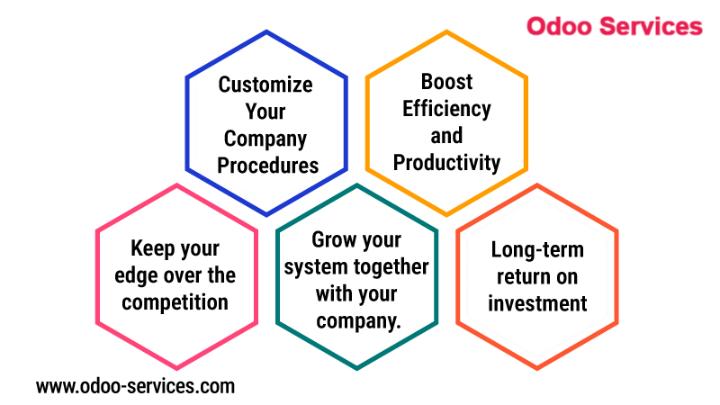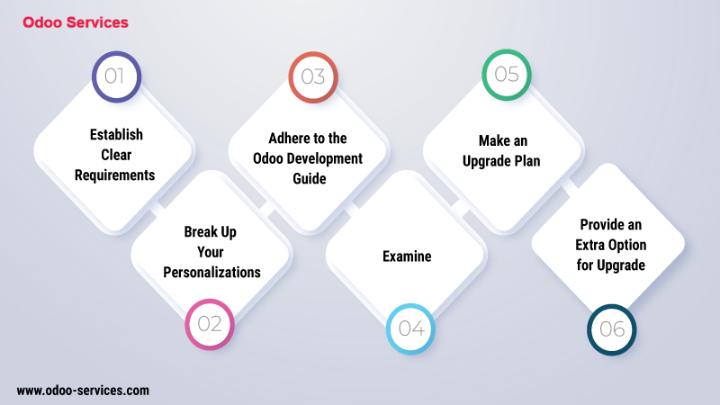From Generic to Genius: The Power of Odoo Customization
In today's fast-paced digital environment, companies are always searching for innovative ways to improve workflows, save expenses, and outperform rivals.The real beauty and worth of Odoo, a robust open-source ERP system with a lot of flexibility, comes when you completely tailor it to fit your unique operations. We want to talk about the benefits of Odoo customisation in this post. In addition to providing some more ideas and pertinent examples, we will assist you in selecting the best partner to maximize the potential of your Odoo modifications
What is Odoo Customization?
Odoo provides an extensive range of pre-built module applications, including CRM, Inventory, Accounting, HR, Manufacturing, eCommerce, and more. But as every company is different, there are opportunities for Odoo customisation there:
- Adapt module workflows to the procedures and industries of your company.
- Make your fields and modules.
- Integrate other tools or third-party apps.
- Automate notifications or repetitive activities.
- Enhance the User Interface (UI) or User Experience to promote increased productivity and user satisfaction.
With proper customisation, Odoo will do more than just "fit" your business; it will become the catalyst for expansion.

Why Customize Odoo?
1. Customize Your Company Procedures
Every firm has a unique method for carrying out its operations. Using an off-the-shelf solution will need you to modify your operation and alter your operations. When it comes to customisation, the system is tailored to your needs.
2. Boost Efficiency and Productivity
Your manual tasks will be automated by the clever custom processes you incorporate into your system. By doing this, you free up your staff to focus on strategic projects rather than manually inputting data.
3. Keep your edge over the competition
Among other things, the bespoke system you create will improve inventory management, decrease order turnaround times, and increase forecasting accuracy.
4. Grow your system together with your company.
You may grow with the customized Odoo solution you create. You will be able to expand the solution to meet the needs of your business as they arise, rather than outgrowing it.
5. Long-term return on investment
Although there may be a short-term expense involved with customized solutions, you will get significant benefits in the meantime. Because you won't need to change your operating procedures to circumvent the system, you'll be more accurate and depend less on other outside resources.
Types of Odoo Customization
A. Improvements to UI and UX
- Redesign dashboards to incorporate data visualization, graphs, and KPIs.
- Make views with layouts, toggles, and dynamic, adjustable filters.
- Make PDF layouts or reports that are customizable to incorporate industry-specific branding and versioning.
B. Business Logic & Workflow Enhancements
- Create invoices automatically and send them as soon as the delivery is confirmed.
- Include status triggers, for example. Automatic resupply alerts.
- Establish validation triggers, such as legality or quantity restrictions.
C. New Model and Module
- Make modules tailored to a particular business, such as attendance records for schools or health care patient logs.
- Define bespoke items, such as quality audits, equipment tracking, and customer contracts.
D. Integrations with Third Parties
- Connect with shipping companies to provide real-time tracking and anticipated costs.
- Connect to logistics APIs, e-commerce platforms, or payment processors.
- To provide drill-down capabilities, connect to data warehouses or BI dashboards such as Power BI.
E. Privileges for Security and Access
- Depending on the job, provide access to particular modules or fields.
- Limit data access according to user levels (e.g., branch level, function level).

Best Practices for Odoo Customization
1. Establish Clear Requirements
Describe the goals, pain points, workflows, and stakeholders. A clear plan will reduce uncertainty and bring all parties together.
2. Break Up Your Personalizations
Utilize repeating modules to divide out your bespoke code. Since the updates and modifications are not instantly included in the Odoo code base, this might be useful if your company needs to upgrade the Odoo version.
3. Adhere to the Odoo Development Guide
Observe the ORM and API guidelines provided by Odoo. In comparison to unstructured code, clean and maintainable code is also simpler to maintain.
4. Examine
Use QA or unit tests to test each adjustment. Test the edge cases and strange flows, such as data volume and other peculiarities.
5. Make an Upgrade Plan
Upgrades can cause customizations to break. To make it as easy and painless as possible for your company to upgrade the modules, version your modules, and document any changes you make. Implement an architecture that is compatible with version upgrades.
6. Provide an Extra Option for Upgrade
To make it easier for whoever takes over the project to get started, provide comments, use a standard naming scheme, and record procedures.
Choosing the Right Odoo Customization Partner
The customization journey is based on the selection of a suitable Odoo consultant. The following is a list of factors to consider and why that factor is significant:
Odoo Certified Developers
Certification provides evidence of depth of knowledge and understanding of the architecture.
Relevance of Industry Experience
They can anticipate and identify issues that may be unique to a business, specifically to that industry.
Communication
Very important for identifying the right requirements and keeping you informed on development cycles and deliverables.
Support & Maintenance
Always ask about Support SLAs, bug fixes, and version upgrades.
Pricing
Ask for fixed bids or hourly estimates with a clearly defined scope.
Why O2B Technologies is Your Go-To Partner
At O2B Technologies, we are focused entirely on customized Odoo solutions that drive real change in your organization. What do we mean by that?
We have:
- We have deep experience with Odoo and ERP workflows.
- A successful delivery record across all industries: Manufacturing, Retail, Services, Education, Healthcare, etc.
- A strong ROI perspective. We link customizations explicitly to results: cost savings, speed, and revenue increase.
- Long-term support. After deployment, we tune and upgrade your system to keep it as fresh and valuable as possible for your team.
Through our proven 3-phase process, we can guarantee seamless custom development across analysis, development, and deployment to a faster go-live and fast wins along the way.

Final thoughts
Customization of Odoo is essential; it is not optional. Customizing your ERP to reflect your workflow and include efficiency, more intelligent choices, and eventually scalability is more important than merely making it seem nice. The onboarding process with the correct partner is more crucial than ever, whether you are creating a whole enterprise automation or modifying a module.
The professionals at O2B Technologies are prepared to assist you in starting your customizing journey if you're ready to start enhancing your Odoo experience. Together, we can create solutions that are as effective as you are.
Need a full-service digital transformation provider? Get a feel for the innovative services of O2B Technologies, your trusted technology partner that offers remarkable technology services such as web and mobile apps, cloud infrastructure, data analytics, and much more. See how O2B can supercharge your ability to do business!
Custom solutions are the way to take your business to the next level. Enjoy customizing!
Frequently Asked Questions
1. What is the time required for customization?
The duration will vary based on the project’s complexity. A minor adjustment will require a few days, while a comprehensive modular development involving intricate integrations will need 4-12 weeks. When effective alignment on the project scope is achieved with a phased rollout approach, everything proceeds more swiftly.
2. If I personalize, will my enhancements not take effect again?
As long as they operate on distinct modules and adhere to proper clean code practices, updates will be executed smoothly, and merge conflicts are anticipated beforehand for SemantiK in variant upgrades.
3. Is customizing inexpensive?
Certainly! There are expenses for implementation; nonetheless, typical factors for Return on Investment include: reduced staff time usage, fewer errors occurring, and enhanced processes. A lot of our clients reach their break-even point in only 6-12 months.
4. What strategies can I implement to maintain my custom system over the long term?
We provide transparent, continuous support and maintenance plans that encompass code reviews, backups, and version migrations, ensuring that you and your organization are utilizing a secure and reliable platform.
5. Is it possible to modify only a single element of Odoo (e.g., sales)?
You can adjust sales without needing to modify or deploy any other elements of Odoo. Our modular strategy is founded on the idea that one can begin with a small scale (e.g., tailored sales quote layout) and expand into other areas as needed.